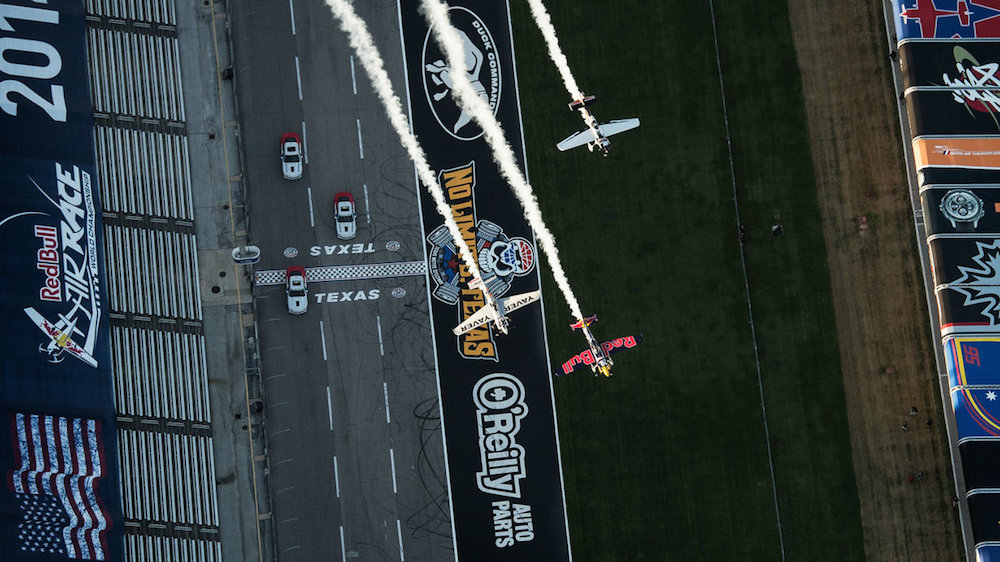Whoosh! Air Race Showcases Extreme Engineering

At the Texas Motor Speedway in Forth Worth, Texas, 12 planes are gearing up for a high-flying aerial showdown Saturday (Sept. 6), on the sixth leg of this year's Red Bull Air Race World Championship.
Reaching speeds of up to 250 mph (400 km/h), the planes' pilots are accomplished aerobatics experts from around the world. But these pros will need more than just flying chops to navigate the challenging slalom course set up inside the speedway.
Whoever wins the race will be aided by advanced light aviation engineering, according to Mike Mangold, an American aerobatics pilot who won the Red Bull Air Race World Championship twice and now serves as a test pilot and commentator during races. [Supersonic! The 10 Fastest Military Airplanes]
"We're flying with very high G forces, at very high speeds and at very low altitudes. And we're doing this within a compact arena that's less than a mile [1.6 km] across," Mangold told Live Science.
Only three models of airplanes are being used for this year's races: the Zivko Edge, the Breitling MXS-R and the Corvus Racer. While they may look slightly different, all three planes have streamlined, aerodynamic bodies that are designed to maximize speed and minimize drag (the force that opposes the plane's movement through the air).
Much of a plane's exterior can also be customized to make it more aerodynamicor to otherwise improve its design. However, there are certain parts of the planes that simply can't be re-engineered.
The engine and propeller, or "power plant," is the same on every plane, Mangold said. An airplane's engine sets certain limits on how fast a pilot can go, because it controls the amount of torque (the work done by the engine that turns the propeller) and thrust (force created by the propeller) that a pilot has to work with in the air, he explained.
Sign up for the Live Science daily newsletter now
Get the world’s most fascinating discoveries delivered straight to your inbox.
The weight of each airplane is also kept standard, at around 1,532 lbs. (695 kilograms). Since lighter airplanes can fly faster, this rule helps ensure that no one gets an unfair advantage.
But besides the plane's engine and weight, the pilots — and the engineers and mechanics who work for them — are free to experiment with their planes' designs, Mangold said.
Some of the parts that can be customized include the cowling, or engine covering; the skins, or the metal sheets that cover the internal parts of the aircraft; the wingtips, the curved ends of the wings that serve to reduce drag); the wheel pans, the bulbous-looking parts that cover the aircraft's front wheels; the shape of the fuselage, or actual body of the plane; and the canopy, the transparent part that covers the cockpit.
Of the three planes flying in this year's race, Mangold said that one, the Zivko Edge, is easier to customize than the others. Nine of the 12 pilots in Saturday's race will be flying some version of the Edge, he said.
"The Edge has a metal tube frame, whereas the [Breitling MXS-R] is a molded carbon-fiber airplane," Mangold said. "It has no metal tubing on it, so it's very difficult to make major changes to it."
Two pilots will be flying the MXS-R on Saturday. One pilot, Peter Besenyei, will be flying the Hungarian-made Corvus Racer, a plane designed specifically for him.
Air racing fans can watch a full-length broadcast of the Red Bull Air Race World Championship from the Texas Motor Speedway on Sept. 15 at 7:30 pm ET on Fox Sports 2 (check local listings).
Follow Elizabeth Palermo @techEpalermo. Follow Live Science @livescience, Facebook & Google+. Original article on Live Science.

Elizabeth is a former Live Science associate editor and current director of audience development at the Chamber of Commerce. She graduated with a bachelor of arts degree from George Washington University. Elizabeth has traveled throughout the Americas, studying political systems and indigenous cultures and teaching English to students of all ages.









